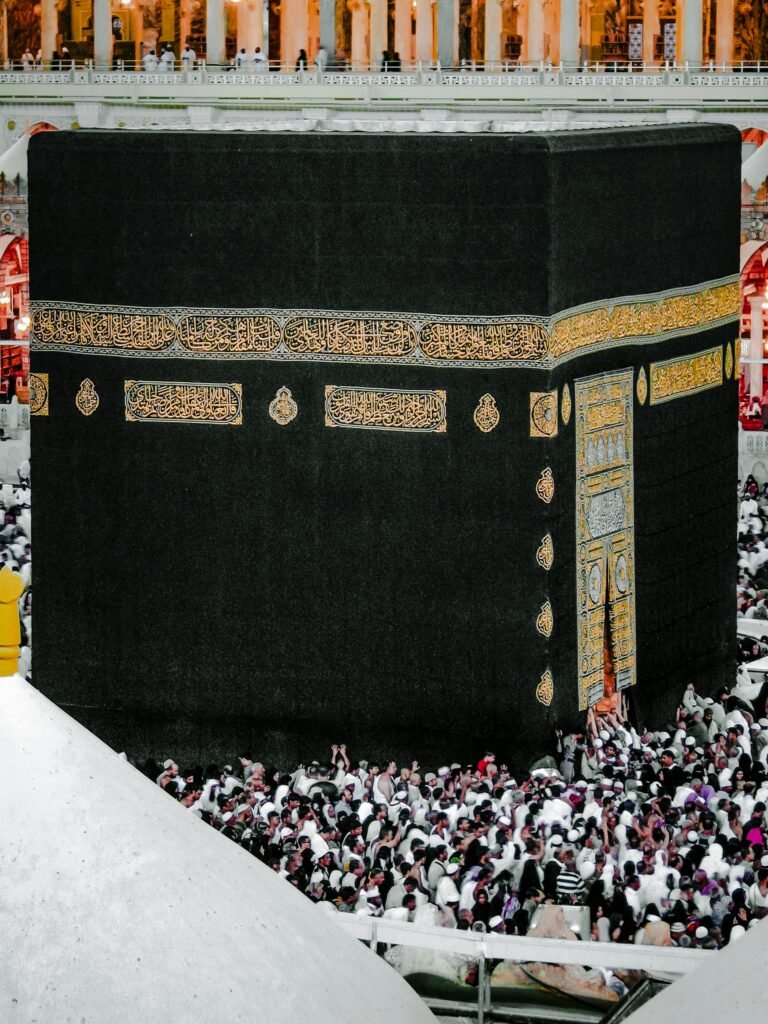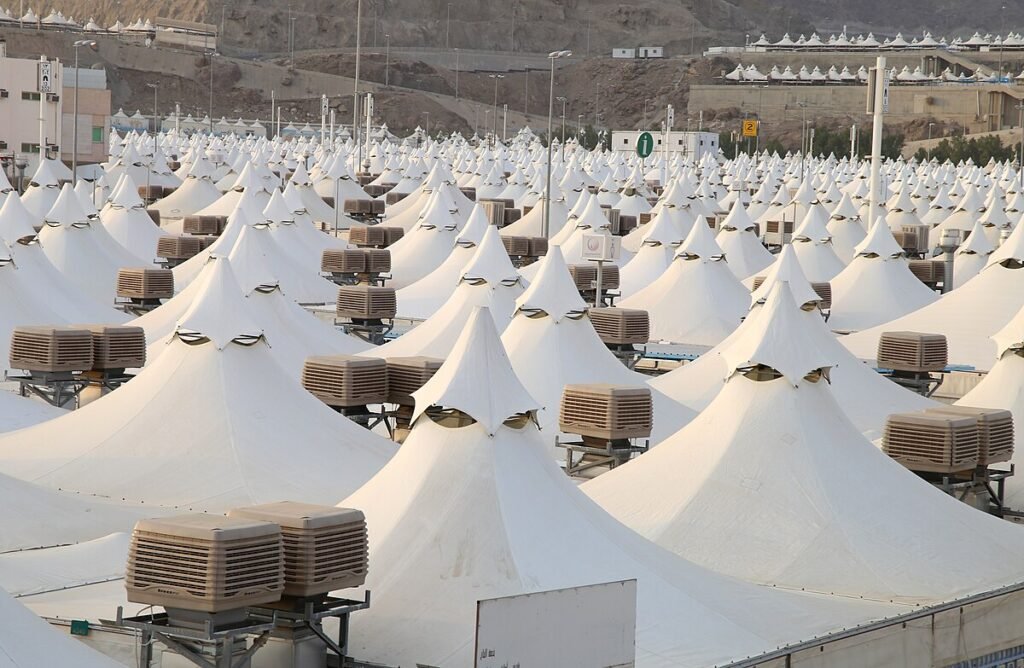Hajj Guide
Experience the pilgrimage of a lifetime with Best Hajj and Umrah Travel Agency – your trusted partner in spiritual journeys.
SubhanAllah, every year about 25,000 Muslims travel from the UK to the holy cities of Makkah and Medina for Hajj, in unison with Muslims from all over the world. So if you are one of the following pilgrims heading to Saudi Arabia to complete this sacred pillar, keep reading! We have compiled this helpful Hajj guide to help you on this blessed journey!
There are three types of Hajj a pilgrim can choose, namely:
- Hajj-ul-Ifrad
- Hajj-ul-Qiran
- Hajj-ul-Tamattu
Hajj al-Ifrad
This refers to performing Hajj rituals alone without the need for a sacrificial animal (Hadee) or Qurbani. The prilgrim who performs this type of Hajj is called Mufrid.
Hajj al-Qiran
In this type of journey, one performs both Hajj and Umrah together while in the state of Ihram. This form requires a sacrificial animal to complete the rituals. The pilgrim who performs this type of Hajj is called Qaarin.
Hajj al-Tamatt’u
Performing Umrah followed by Hajj requires sacrificing a lamb. The pilgrim dons Ihram for Umrah during Hajj months. After Tawaf, Sa’i, and cutting her hair, she is freed from Ihram. On the 8th of Dhul-Hijja, he dons Ihram for Hajj and sacrifices a lamb, following the Prophet's instruction for "Tamattu."
Steps of Hajj:
- Preparation and Intention
- Enter state of Ihram
- Tawaf x7
- Safa and Marwa
- Clip/Shave Hair (Umrah ends)
- Resting and Praying
- Enter state of Ihram
- Arrive at Mina
- Day of Arafah
- Muzdalifah (under the night sky)
- Rami (stoning of the devil)
- Qurbani
- Shave Head
- Tawaf al-Ifadha
- Rami (stoning of the devil)
- Spend night at Mina
- Rami (stoning of the devil)
- Farewell Tawaf al-Wida
When Can I Perform Hajj?
In Islam, as we work on the lunar calendar (unlike the Gregorian calendar), the exact days of Hajj vary from year to year. Within the Islamic calendar, Hajj is performed between the 8th and 12th days of Dhul Hijjah – the last month of the Islamic year.
These days Hajj pilgrims go to Makkah by air, sea, and land during the days and weeks before the time to go to Makkah. From the UK you can fly to Saudi Arabia, to Jeddah or Medina. From there you will take your Hajj group to Makkah.
Enter Ihram (sacred condition)
Ihram is the state of the spirit that you enter once you have made the intention of going for Hajj. The first pilgrimage to Hajj is ihram – a sacred rite of passage for a pilgrim – as it crosses the outer border of Mecca, called Miqat.
On the eighth day of Dhul-Hijjah, pilgrims enter the ihram, which includes the wearing of loose clothing – two non-woven men’s clothing, or women’s open clothing – as well as following certain rules, such as refraining from getting angry or having sex. function. Umrah
On arrival in Makkah, you will first perform your umrah, which means you will do your tawaf and sa’i.
Tawaf
Tawaf al-Ziyarah
This tawaf (also called ‘tawaf al’ifadah’) is performed by pilgrims after reciting the deeds of Mina, the ramy of jamarat al’aqabah, the sacrifice (dhibh), and the halq or taqsir. The traveler performed this tawaf on his way back to Makkah. It is called ‘tawaf alziyarah’ because it is performed on a visit (ziyarah) to the Ka’bah after leaving Mina. It is called ‘tawaf al’ifadah’ because travelers pour (‘fadah’ meaning ‘pouring’) on Makkah from Mina. It is also called ‘tawaf alhajj’ because according to all the schools the rukn of Hajj.
After performing this tawaf everything is permissible for a (Sunni) pilgrim, even having sex with women. The Imamiyyah, who disagrees with it, says that sex is not permitted before performing sa’y between Safa and Marwah followed by the second tawaf, which they call ‘tawaf alnisa’. ‘ This will be clarified now
Tawaf al-Wada
It is the last tawaf performed by Hujjaj before leaving Makkah. The schools of Hanafi and Hanbali take it as an obligation, although all that is required of the non-payer is sacrifice. The Malikis consider it a mustahabb and do not need any penalty automatically. AlShafi’i has two opinions on the matter. (alMughni, alFiqh ‘ala almadhahib al’arba’ah, Fiqh alSunnah)

Safa and Marwa
After performing your tawaf, you will be performing what is known as the sa’i – walking and running between the two hills of Safa and Marwa. You will start the sa’i at Safa and walk towards Marwa until you see the green mark where you will run until the next green mark, and continue on until you reach Marwa. This completes one episode. You will then return to Safa to complete your second episode. Your Sa’i is complete once you have played seven rounds between Safa and Marwa.
This is an important custom in memory of Ibrahim’s wife Hajar (AS) and her struggle in the desert for her son the Prophet Ismail (AS). Sa’i symbolizes the ongoing struggle we face throughout our lives, as Hajar (AS) saw for himself.
Once the sa’i is complete, men will cut their hair or shave while a woman cuts her hair to the length of her finger. This marks the end of your umrah, which allows you to leave ihram, until the 8th of Dhul Hijjah.
8th Dhul Hijjah (Hajj Guide)
The 8th day of Dhul Hijjah marks the beginning of the days of Hajj and the next stage of your spiritual journey. You’ll purify yourself and enter the state of ihram once again.
It’s very important to note that you are in a state of ihram and you are not permitted to smoke, swear, shave, clip your nails, or engage in any form of sexual relations. Fighting and arguments are also banned, and participants are prohibited from hunting, killing or unjustifiably breaking anything. You must also avoid scented products such as perfumes, moisturisers, makeup or soaps. You may, however, substitute them for unscented toiletries which are permissible to use.
Once you’re all set, you’ll begin reciting the following invocation called the talbiyah:
لَبَّيْكَ اللَّهُمَّ لَبَّيْكَ، لَبَّيْكَ لاَ شَرِيْكَ لَكَ لَبَّيْكَ، إِنَّ الْحَمْدَ وَالنِّعْمَةَ لَكَ وَالْمُلْكَ لاَشَرِيْكَ لَكَ
Labbayka Allāhumma labbayk. Labbayk lā shareeka laka labbayk. Inna al-ḥamda, wa n-‘imata, Laka wal mulk. Lā shareeka lak.
“Here I am, O Allah, here I am, here I am. You have no partner, here I am. Verily all praise and blessings are Yours, and all sovereignty. You have no partner.”
You will then proceed with your Hajj group to the tent city of Mina, which lies roughly eight kilometres away from Makkah.
Mina
The travelers then traveled in large numbers from Mecca to the bustling city of Mina, either on foot or in buses and cars. 8 km trip.
When you get to Mina you will settle in your tent. Here you will recite dhuhr, asr, maghrib, isha and fajr, shortening your four prayers into two units each, without merging it, as stated in the Quran.
Spend the night and pray to Allah (SWT), recite the Qur’an and prepare for the second day. It is an important time for spiritual meditation and dedication, so try again and make the most of this special night

9th Dhul Hijjah (Hajj Guide)
Now that you’ve performed umrah, for the rest of this blessed month, you’ll stay in Makkah to complete your spiritual journey of Hajj surrounded by your fellow Muslim brothers and sisters, SubhanAllah!
Performing Hajj
Fulfilling your sacred obligation of Hajj will be the most spiritual period of your life insha’Allah, filled with blessings and forgiveness from Allah (SWT)!
Spend the day at Arafat
The Day of Arafat is considered one of the most important days, not just of Hajj, but of the Islamic calendar. Mount Mercy at Arafat was the scene of the Prophet Muhammad’s final sermon. After making the 14.4 km journey from Mina, pilgrims spend the day here in reverent prayer.
ا إِلَهَ إِلَّا اللَّهُ وَحْدَهُ لَا شَرِيكَ لَهُ لَهُ الْمُلْكُ وَلَهُ الْحَمْدُ وَهُوَ عَلَى كُلِّ شَيْءٍ قَدِيرٍ . اللَّهُمَّ اجْعَلْ فِي قَلْبِي نُورَاً وَفِي سَمْعِي نُورَاً وَفِي بَصَرِي نُورَاً اللَّهُمَّ اشْرَحْ لِي صَدْرِي وَيَسِّرْ لِي أَمْرِي وَأَعُوذُ بِكَ مِنْ وَسَاوِسِ الصُّدُورِ وَشَتَاتِ الْأَمْرِ وَفِتْنَةِ الْقَبْرِ اللَّهُمَّ إِنِّي أَعُوذُ بِكَ مِنْ شَرِّ مَا يَلِجُ فِي اللَّيْلِ وَشَرِّ مَا يَلِجُ فِي النَّهَارِ وَشَرِّ مَا تَهِبُّ بِهِ الرِّيَاحُ
“There is none worthy of worship besides Allah, He is all by Himself, He has no partner, His is the Kingdom, for Him is all praise, He has power over all things. O Allah, make Nur in my heart, in my ears Nur and in my eyes Nur. O Allah open my chest (bossom), make my tasks easy and I seek refuge in You from the whispers of the chest, from disorganisation in working and from the punishment of the grave. O Allah, I seek refuge in You from the evils that come with the wind”.
After praying the fajr salat in Mina, you will then head for the plains of Arafah, say staghfar [asking for forgiveness] and supplicate, marking the Day of Arafah when we ask Allah (SWT) for forgiveness of our sins. Arriving on the plains of Mount Arafah, the pilgrims see the dhuhr and asr prayers combined and abridged (two rakat instead of four).
Muzdalifah
After sunset, its time to move again, this time to Muzdalifah – a 9 km trip – where they spend the night under the stars. Many will also begin collecting pebbles here for tomorrow’s rites, departing again just before sunrise.
Once you reach Muzdalifah you’ll perform your maghrib and isha salah, one after the other, shortening isha salah to two rakat.
As Abdullah ibn Umar (RA) narrates:
The Prophet (SAW) offered the maghrib and isha prayers together at Muzdalifa with a separate iqama for each of them and did not offer any optional prayer in between them or after each of them.
Afterwards, you can then spend the night in worship or resting. The Prophet (SAW) went to sleep until shortly before fajr, choosing not to engage in night worship as he normally did. So, don’t be tempted to exhaust yourself but rest instead – you have a long day ahead of you!
While in Muzdalifah, you may also collect pebbles to perform rami [the stoning of the devil] over the next three days. The size of the pebbles should be similar to the size of date stones/seeds. You will need a total of 49 pebbles. The breakdown is as follows:
- 7 for the 10th of Dhul Hijjah
- 21 for the 11th of Dhul Hijjah
- 21 for the 12th of Dhul Hijjah
Throw stones at the pillars
For those performing Hajj, the day is known as yawm-ul hajj al-akbar (The big hajj day) and is probably the longest day of the pilgrimage, and the most dangerous.The 10th of Dhul-Hijjah is Eid al-Adha, a day celebrated by Muslims around the world as the greater of the two Muslim holidays. Pilgrims start the day in Muzdalifah and begin heading back to Mina before dawn. Once in Mina, they perform the first rami, throwing seven pebbles at the largest of three columns known as Jamarat.

This act is a symbolic stoning of the devil, based on historical tradition. God told Abraham to sacrifice his son, the story goes, as proof of faith. It is believed that at this spot in Mina, the devil appeared and tried to dissuade Abraham from heeding the command. Abraham responded by throwing stones to scare him off.
Tawaf al-ifadha
You will now go to Makkah to perform tawaf al-ifadha and sa’i as part of your Hajj rituals.
Tawaf al-ifada and sa’i are obligatory. You must perform them after the rami, sacrifice and shaving (or trimming) of the head. On 10th and 12th Dhul Hijjah, the tawaf and sa’i can be done.
With the completion of this tawaf and sa’i, you are then allowed to relax and do everything that was lawful before ihram, including engaging in marital relations. You will, however, return to your tents in Mina and continue with the remaining rituals of Hajj.
Eid al-Adha
The festival of Eid al-Adha, or the Feast of Sacrifice, is celebrated by Muslims who are not on pilgrimage. They slaughter animals to mark Prophet Ibrahim’s willingness to sacrifice his son Ismail (AS) upon the command of Allah (SWT).
Tawaf al-wida (the farewell tawaf)
Before departing from Makkah, the farewell tawaf is the last rite we perform. It is wajib (obligatory) and must be performed prior to leaving the boundaries of the Haram. Omitting this tawaf, without a valid reason, is not deemed lawful in Islam. Ibn Abbas (RA) narrated:
The people were ordered to perform the tawaf al-wida as the last thing before leaving (Makkah), except the menstruating women who were excused.
For this tawaf, you will complete the seven laps of tawaf. Then perform two rakat of salah and drink zam zam water. There is no sa’i or shaving/trimming of the head after this tawaf.
Craft Sacred Memories in Hajj and Umrah
Experience Sacred Moments on Your Hajj and Umrah Journey.



